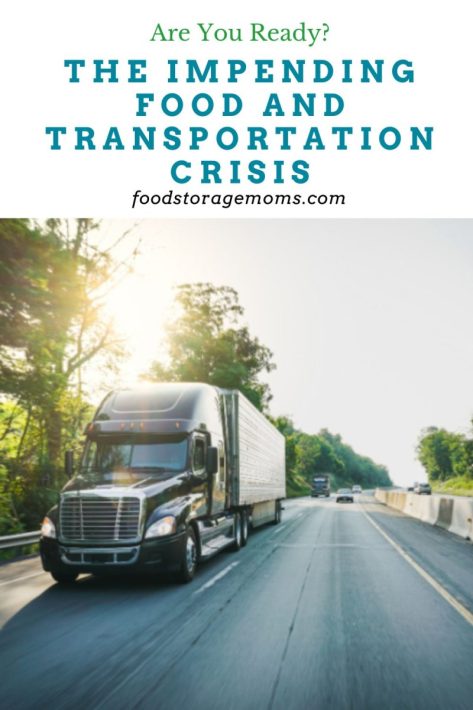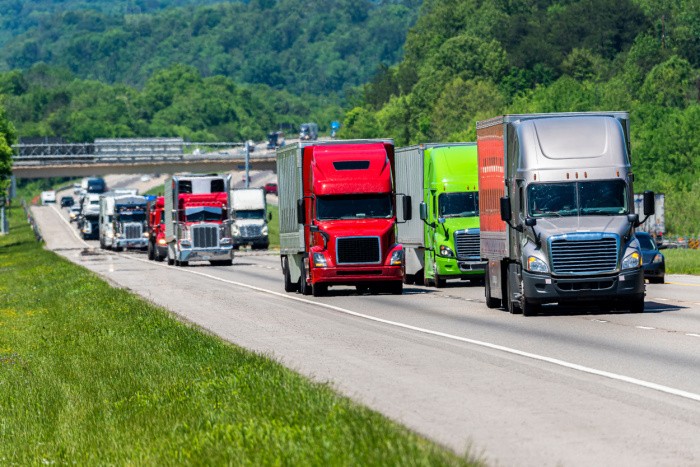Let’s discuss concerning the impending meals and transportation disaster right now. A rising storm is brewing internationally’s meals and transportation methods. From unpredictable climate patterns to international conflicts, financial instability, and gasoline shortages, the cracks are widening within the networks that maintain grocery retailer cabinets stocked and items shifting.
Whereas most individuals go about every day life assuming that vehicles, trains, and ships will proceed delivering as common, specialists warn that these methods are much more fragile than they seem.


Current disruptions from rising diesel costs and port slowdowns to fertilizer shortages and dwindling farmland have revealed simply how interconnected and susceptible our provide chains are. When one hyperlink breaks, the ripple results can attain each family. Meals turns into dearer, deliveries take longer, and small shortages in a single area can shortly unfold throughout the nation.
Governments and logistics firms are scrambling to strengthen infrastructure and diversify sourcing, however with international inflation and strained assets, the problem grows extra complicated annually. The query isn’t whether or not the disaster will come; it’s how extreme it will likely be and the way ready we’ll be when it hits.
The Impending Meals and Transportation Disaster
- “What’s Inflicting the Disaster?”
- “The Position of Vitality and Transportation Prices”
- “How Meals Shortages Unfold”
- “What You Can Do To Put together”?
A Good Storm within the Making
The world’s meals and transportation methods are below rising pressure. From rising gasoline costs and labor shortages to unpredictable climate and geopolitical conflicts, the warning indicators are in every single place. These mixed pressures threaten to create a meals and transportation disaster that might impression each family, from the provision of fundamental groceries to the price of on a regular basis items.
What’s Inflicting the Disaster?
A number of elements are colliding directly:
- Gas Prices: Transportation depends closely on diesel and fuel. As vitality costs rise, so do the prices of delivery meals and items. Trucking firms move these bills to distributors, who move them to customers.
- Provide Chain Fragility: Our just-in-time supply mannequin leaves little room for error. One breakdown in trucking routes, ports, or rail strains can delay meals distribution for days or perhaps weeks.
- Labor Shortages: A scarcity of truck drivers, warehouse staff, and farm laborers has slowed manufacturing and deliveries worldwide.
- Excessive Climate: Droughts, floods, and warmth waves have destroyed crops and disrupted harvest schedules, chopping meals provides and driving up costs.
- Geopolitical Conflicts: Wars and commerce disputes can restrict exports of important assets like grain, fertilizer, and gasoline, amplifying shortages throughout continents.
The Position of Vitality and Transportation Prices
Vitality is on the coronary heart of the worldwide provide chain. Each product, from greens to electronics, is dependent upon transportation. When gasoline costs rise, the consequences cascade by means of each stage of the economic system. Meals turns into dearer to develop, course of, and transport.
Even small will increase in diesel costs can considerably elevate grocery payments, particularly for gadgets that journey lengthy distances, like produce and dairy.
How Meals Shortages Unfold
Meals shortages hardly ever begin in a single day; they construct slowly.
When farmers face excessive fertilizer or gasoline prices, they plant much less. When transportation falters, deliveries are delayed. Small shortages in a single area can shortly unfold nationwide as customers panic-buy or stockpile. The consequence? Empty cabinets, inflated costs, and restricted choice.
The Human Issue
The transportation sector is dependent upon folks, drivers, mechanics, dock staff, and farmers. As extra staff retire or depart these industries, fewer replacements are stepping in. With out sufficient manpower, even essentially the most superior logistics methods falter.
How You Can Put together
You possibly can’t management the worldwide provide chain, however you can management your family readiness. Listed here are some sensible steps:
- Construct a 3–6 Month Meals Provide: Give attention to shelf-stable meals like rice, beans, canned meats, grains, and dehydrated produce.
- Inventory Up on Necessities: Maintain additional gasoline, water, and fundamental medical provides readily available. Water Filters and WaterBricks
- Help Native Meals Sources: Purchase from close by farms and neighborhood growers to scale back dependency on nationwide distribution.
- Develop a Backyard: Even small container gardens can produce greens and herbs to complement your weight loss program. My Favourite Backyard Basket-Hod and Digz Backyard Gloves
- Keep Knowledgeable: Observe dependable sources that observe agricultural and vitality traits.
- Will meals shortages worsen in 2025?
- Which meals are almost definitely to vanish first?
- What are the perfect meals to retailer long-term?
FAQ: The Impending Meals and Transportation Disaster
Will meals shortages worsen in 2025?
Sure, many specialists consider meals shortages will proceed into 2025 and presumably worsen. International inflation, excessive gasoline prices, and unpredictable climate have mixed to scale back manufacturing and pressure provide chains. Even when crops recuperate, transportation delays and vitality prices will maintain costs excessive for months to return.
Which meals are almost definitely to vanish first?
Meals that rely closely on transportation or import routes have a tendency to fade first throughout disruptions. These embrace:
- Contemporary produce (vegatables and fruits)
- Dairy merchandise
- Meats and poultry
- Imported grains, espresso, and spices
Shelf-stable items equivalent to canned beans, pasta, and rice often last more however may turn out to be dearer over time.
Why are transportation issues inflicting meals shortages?
Transportation is the spine of the meals system. If vehicles can’t transfer items effectively as a result of gasoline shortages, driver strikes, or infrastructure issues, meals doesn’t attain grocery shops. Even minor delays may cause spoilage and regional shortages, particularly with perishable gadgets.
How can households put together for potential shortages?
Begin small and concentrate on constructing a gradual reserve:
- Retailer what your loved ones already eats, and purchase additional when it’s on sale.
- Rotate inventory frequently so nothing expires.
- Maintain a mixture of canned, dried, and frozen meals.
- Study fundamental meals preservation abilities, equivalent to dehydration or canning.
- Plan meals that use fewer perishable elements.
What function does vitality play within the meals disaster?
Vitality drives each stage of meals manufacturing from planting and harvesting to packaging and supply. Rising oil and fuel costs elevate the price of fertilizer, farm tools operation, and delivery. When vitality prices rise, meals prices comply with virtually instantly.
How lengthy ought to I put together to be self-sufficient?
A superb beginning purpose is a three-month meals provide to your family. Lengthy-term preppers usually purpose for six months to a yr, relying on area and price range. Give attention to nutritious, non-perishable staples that meet your loved ones’s dietary wants.
How Are Our USDA and Agriculture Experiences
What the USDA Experiences Are Telling Us (Constructive Alerts)
- Robust U.S. crop manufacturing estimates. Within the latest World Agricultural Provide and Demand Estimates (WASDE) and the Crop Manufacturing report, the USDA projected a document corn crop: for instance, 16.7 billion bushels with yields round 188.8 bushels per acre. DTN PF+2Successful Farming+2
- That’s a constructive for supply-side: extra output doubtlessly means much less danger of an acute scarcity (a minimum of for that commodity).
- Increased yields and elevated acreage assist cushion provide fallback from climate or transportation disruptions.
- Common, clear reporting schedule: The USDA publishes frequent, scheduled studies: weekly crop progress/situation throughout rising season, month-to-month provide & demand (WASDE) for main crops, export gross sales weekly, and many others. usda.gov+2usda.gov+2
- This implies now we have fairly well timed knowledge to observe for early indicators of hassle.
- Crop situation studies present first rate well being in lots of circumstances. For instance, in a latest week, about 72% of U.S. corn was rated “good-to-excellent” situation. Farm Progress
- Whereas not excellent, this implies many crops will not be but in emergency situation.
Areas of Concern / Warning Indicators within the USDA Knowledge
- Excessive provides can nonetheless translate into logistical points: Although yield and manufacturing are sturdy, having the crop is one factor; getting it from area to client is one other. The USDA’s studies present provide is there, however they don’t all the time mirror transportation delays, gasoline price spikes, and infrastructure bottlenecks straight. So sturdy manufacturing doesn’t assure clean supply.
- Crop situation trending downward in some areas: Whereas many crops charge “good-to-excellent”, some rankings have slipped. Instance: soybean “good-to-excellent” dropped one level to 68% in a latest report. Farm Progress
- Circumstances slipping may portend decrease yield or high quality points if climate or different stresses worsen.
- Exports & demand uncertainties — The USDA’s weekly export gross sales knowledge present some weak spots: for instance, soybean web gross sales for some advertising and marketing years are down versus prior averages. USDA Apps
- If demand softens, producers might reply by planting fewer acres subsequent yr, thereby decreasing future provide.
- Transport/distribution danger not absolutely captured. The USDA studies focus primarily on manufacturing, shares, acres, yields, and situation. Much less so on e.g., port congestion, truck driver shortages, gasoline surcharges, intra-state distribution disruption. This implies even with sturdy manufacturing, there could also be “invisible” bottlenecks.
- Regional & crop‐particular fragilities, Robust general numbers (e.g., for corn) might masks weak spots in different crops (fruits/greens, specialty crops) or in particular areas. These weaker crops could also be extra susceptible to transportation or climate shocks, even when headline numbers look okay.
Implications for Meals & Transportation Disaster Outlook
Placing the USDA knowledge into the context of your concern (meals & transportation disaster), right here’s what it suggests:
- As a result of the USDA is reporting substantial provide numbers in key staples (e.g., corn) this diminishes the rapid danger of a meals manufacturing collapse for these staples. That’s good.
- Nonetheless, the transportation/distribution layer stays a wildcard. Even with loads of manufacturing, if vehicles, rails, or ports get jammed, or gasoline/driver prices spike, the meals might not attain customers effectively.
- The truth that crop circumstances are degrading in some areas means we must always carefully monitor whether or not the upcoming harvests nonetheless meet projected numbers or if there are high quality points that may impression provide, worth, and availability.
- Export/demand uncertainties might cut back the inducement to plant subsequent season, doubtlessly decreasing provides past the close to time period.
- For perishable or much less‐tracked classes (fruits, greens, specialty crops), USDA studies might not present the identical degree of granularity. Nonetheless, these are exactly the gadgets almost definitely to be disrupted by transportation or labor shortfalls.
Methods to Maximize Your Backyard’s Manufacturing
Methods to Put together for a Meals Scarcity
My Abstract Judgment
In plain phrases, the USDA’s latest studies supply some reassuring supply-side indicators for main staple crops within the U.S., which is excellent news for avoiding an outright collapse in meals availability.
Nonetheless, and that is necessary, they don’t eradicate important dangers, particularly in distribution, logistics, labor, and non-staple crops. The larger concern will not be “we’re going to expire of corn” however quite “corn is there however we are able to’t get it the place it must go in the fitting kind/time, or the associated fee turns into prohibitive.”
In brief, the availability basis is fairly strong (for staples), however transportation & system stress stay important vulnerabilities.
Closing Phrase
The worldwide meals and transportation methods are below super stress, and whereas we are able to’t stop large-scale disruptions, we can cut back their impression on our lives. Constructing a house meals reserve, supporting native farmers, and planning are easy steps that make a giant distinction when the sudden occurs.
The upcoming meals and transportation disaster isn’t only a distant chance; it’s a rising actuality. By recognizing the warning indicators and getting ready now, you’ll be able to shield your loved ones from rising costs, empty cabinets, and uncertainty. Preparedness isn’t panic, it’s peace of thoughts in unsure instances. Might God bless this world, Linda
Copyright Photos: Semi 18 Wheeler On Freeway AdobeStock_302943937 By 5m3photos, Vehicles on Tennessee Interstate AdobeStock_313923692 By Carolyn Franks


